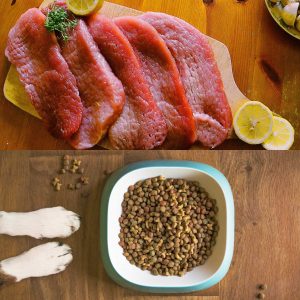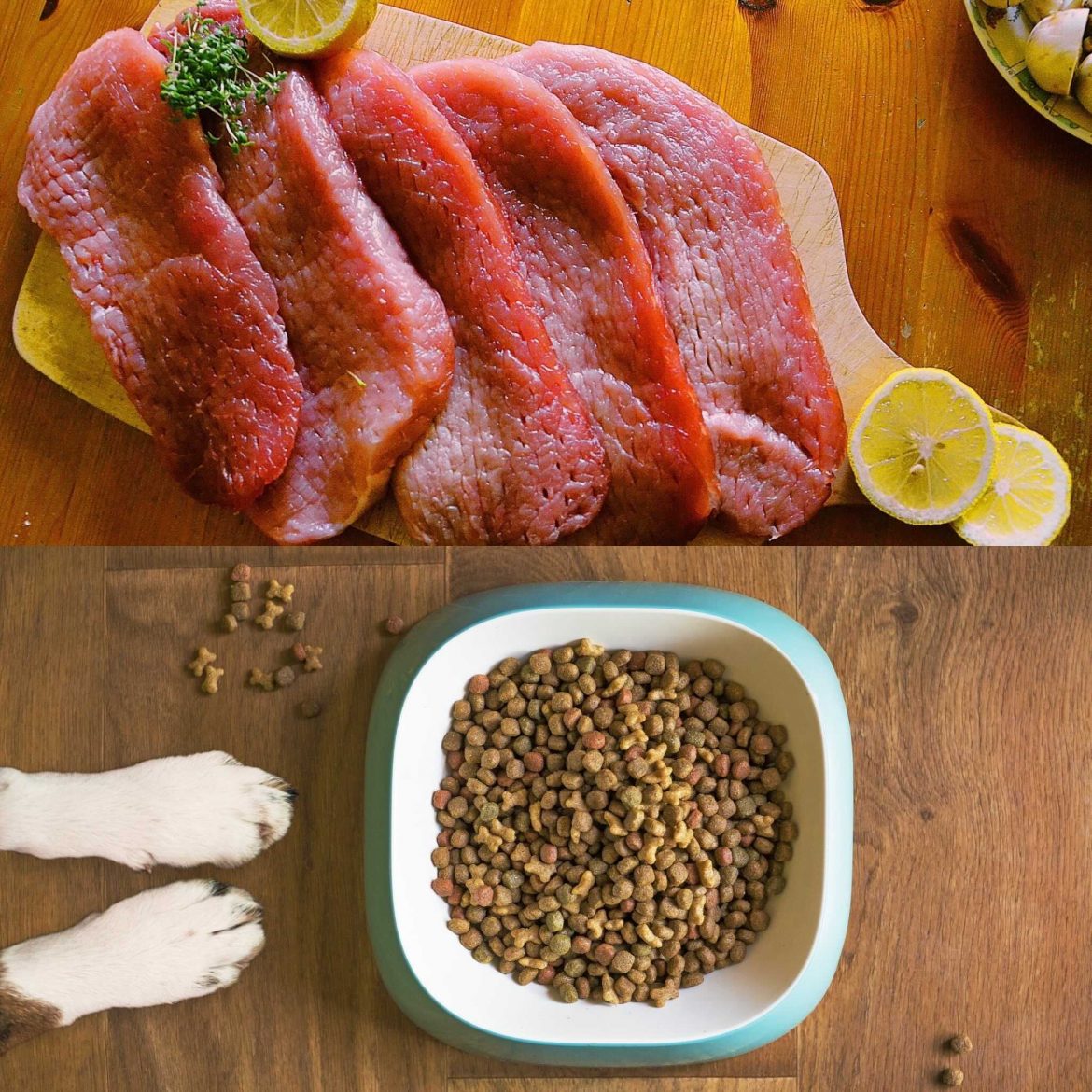For as long as people have cared for pets, there have been debates over which food is best for them. These days, the topic is more complex than ever; canned food vies against home-cooked meals, pro-grain and anti-grain fight tooth and nail, even vegan meals have made their way into the dog food game. Amidst these nearly countless options, two meal choices have emerged as some of the most popular: raw food and kibble. At a glance, it’s easy to view the two meal choices as rivals. Even so, the subject is a bit more nuanced than “raw food vs kibble”. In fact, when done right, the two can even complement each other as part of a balanced diet.
Join us as we compare raw food with premium kibble and give you the data to make the right choice!

Raw food vs kibble: why is there even a rivalry?
As with much of what fills a competitive market place, the “raw food vs kibble” debate stems from optics. One one hand, kibble seems like a hallmark of the Industrial Age. Highly processed and easy to store, kibble markets itself as a convenient, cutting edge nutrition option. Simply open the packet, measure your pup’s meal potion, and serve. Of course, kibble-lovers will assure you that it isn’t only about ease of prep time. “Kibble is scientifically formulated to meet your dog’s needs,” they argue. “It reflects the latest trends in canine health, so why deprive your dog of it?”
By contrast, raw food appears as a high-protein, all-natural source of nutrients that aligns with your pup’s biology. While it may take slightly longer to prepare, its freshness and crude protein make it worth the effort for your pooch. Also, isn’t this how our dogs evolved to consume their nutrients? “You don’t need a lab to create what nature already provides,” raw food advocates say. “Dogs have eaten this way for thousands of years, and it’s what their bodies require. And if you doubt us, just watch your dog eating both food types. Afterwards, you’ll have no doubt that they enjoy their raw food more.”
Both are compelling arguments, right? But which of them is true? To an extent, the answer is: “they both are.” We know that doesn’t make your decision any easier, so bear with us as compare the two.
Raw food makes your dog happier
Some dogs would eat expired cookie dough if you put it in front of them (but please don’t…). Other pups are much more fussy diners, and will only eat their fill if they enjoy what’s in their bowl. If your dog falls into this latter group, you’re far more likely to have luck by feeding them raw food. As a general rule, they appreciate the taste and texture of raw meals much more than their dry counterparts. For dogs who only eat what they enjoy, this can make the difference between a full and an empty stomach.
Even if your dog isn’t choosy about what they eat, a raw food diet can have its perks. By enjoying meal time, your pup will reap psychological benefits that are crucial for their development.
Kibble and raw food provide different fibres
Like humans, dogs depend on fibre to maintain bowel and gut health. While both raw meals and premium kibble can contain fibres, they differ in the types they provide. Generally speaking, premium kibble will contain fibre enhancers like cellulose, which our dogs’ stomachs will process more rapidly. In contrast, dog-friendly raw veggies feature fibres that fulfil a prebiotic role, which trigger the growth of healthy gut bacteria. Put simply, raw food and kibble fibres offer different solutions to a similar problem.
Different strands of protein for different strengths
While the best ones feature dog-friendly veggies, most raw food diets are built around a centrepiece of raw meat. This is good news, because raw meat is high in protein – the macronutrient crucial for muscle growth and repair. In puppies, these proteins will help grow the muscles in their legs and around their hearts. In older dogs, maintenance is the name of the game, and at this proteins excel.
If we look at kibble, though, we find that amino acids is where they shine. While raw meats contain these as well, amino acids form the building blocks of muscle growth. As such, it can benefit your pup to receive their amino acids from more than one source.
Raw food vs kibble: why not both?
After combing through the facts, we’ve concluded that the best meal is one which features raw food with some premium kibble. Mix your pup’s raw meals with some top-tier dry food, and they’ll enjoy the best of both worlds.
NOTE: as each dog is unique, the above advice is general in nature. If you’re not sure about the specific dietary needs of your pup, play it safe and ask your vet.
Are you looking for a meal plan that gives your dog the best that raw food has to offer? Sign up to Mad Paws Dinner Bowl today!

